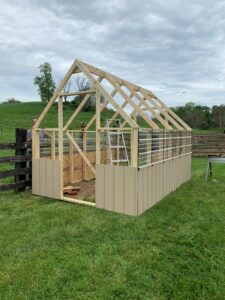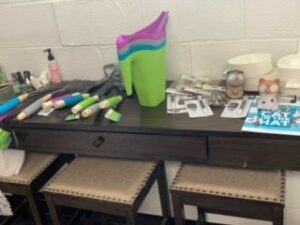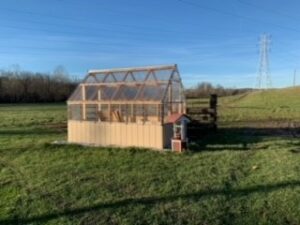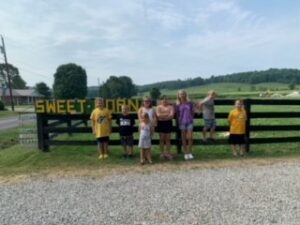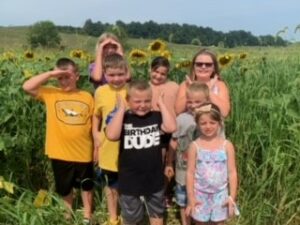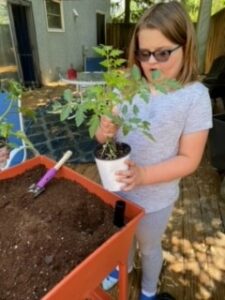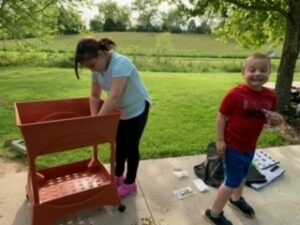Final report for YENC21-159
Project Information
The Farm-to-table gardening project will teach youth how to grow plants and preserve food for personal consumption or to sell at a farmers market. The pandemic has created an awareness that food shortages are real and the rural communities can grow some of their own food or purchasing from local farmers. The Burleson farm and TerraCotta B&B can provide a place to teach growing, cooking, and food preservation practices to local youth. Involving a team of people to teach gardening, meal planning, and nutritional value of growing your own food with a sustainable outcome.
- The youth learned that sustainable agriculture is farming animals or growing food in a way that improves the soil and is sustainable for farm familes. They learned this by visiting the Burleson beef farm, the Mckean's farm, the community garden, and growing their own vegetables. The raised bed containers will be used again to raise more produce for their families this summer. Each student will be able to chose what they want to grow, now that the project is complete.
- The educational approach was similar to a club. There were planning meetings, house visits, field trips, presentations, and team work.
- The project goal was to teach participants where their food comes from, this was accomplished through planned and organized activities and field trips.
- The youth will be growing their own produce again this summer. The educator had to plan and create a timeline to share with the families on caring for their salsa garden. This required sending messages and video's on how to care for the plants. The parents were supportive in helping teach the youth on how to tend to the garden.
Success story: A few of the participant do not like to eat vegetables. Because they grew their own vegetables and were able to choose what they wanted at the farmer's market, they tried eating new fruits and vegetables. Any mom would consider that a SUCCESS.
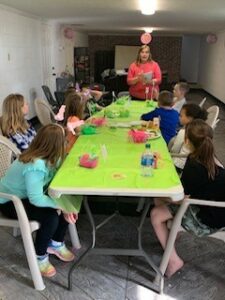
- Increase sustainable farming skills for youth through hands-on experiences.
- Introduce youth to sustainable agriculture careers and various gardening methods through visits to local farms and the farmers market.
- Create a community greenhouse and garden by growing plants from seed.
- Teach students the skill of growing, preserving, and cooking sustainably grown produce.
- Plan a dinner menu with emphasis on nutrition.
- Host a farm-to-table dinner, using the produce grown by participants or local farms.
- Share project results through presentations and social media.
Educational & Outreach Activities
Participation Summary:
The project was designed to have the students participate from planning to completion. It was planned to include all ages of children. The younger children were able to help plant the vegetables in their salsa garden, as well as water and harvest produce. The older children helped with the planting and harvesting. They also were able to make salsa and guacamole. The menu they planned was a taco dinner, which used meat from the farm, produce that was grown on the farm, and produce that was purchased at the farmers market. To complete the project, the students were asked to describe what they have learned. This allowed them to practice doing a presentation. They each were able to articulate what was learned. The sustainable plan for the project is to have the students use the raised bed and grow what they want next year. I would also encourage youth to add more containers to their gardens.
On the educational side, they learned about raising cows and how to care for livestock. The families involved in the project purchase meat from the Burleson Farms. The students were able to see how the meat gets from the farm to their table. They also learned about the food pyramid and nutrition. Each student used a portion plate to see the serving sizes. Nutrition was discussed while preparing the meal. Grandparents and parents were invited to the dinner that was prepared by the students. They shared what was learned from doing the project and how they will continue to use this information in the future.
The students are also interested in joining 4H. This project was planned to encourage them to continue doing projects and presentations.
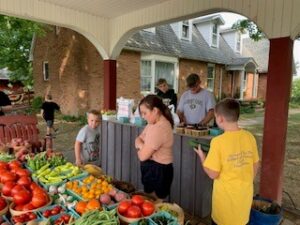
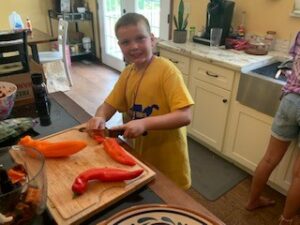
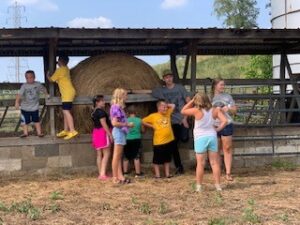
Learning Outcomes
The students learned about farming, planting, and harvesting vegetables through hands-on experiences through:
1. A planted and harvested raised bed salsa garden.
2. Visit to the Burleson Farm
3. Toured local farm and purchased produce
4. Planned and prepared a dinner from local farms
5. Picked produce from community garden
6. Presentation on what was learned from project
Project Outcomes
The project supported the families by purchasing a raised bed that can be reused for growing food for them in the future. The students learned how to plant, water, and harvest vegetable to make their own salsa. The parents supported the project by helping with the salsa garden. The students will be able to choose what they want to plant and grow in the raised beds this next season. The plan is to keep them trying new food items each year.
The Columbus family shared their gardening practices with a neighbor. The kids allowed their friends to help plant and grow a container garden on the patio.
One of the families, from southern Ohio, already started planning to grow some of their own food before being asked to participate in the project. They were thrilled to be a part of the project. They plan to start a bigger garden next year, along with their raised bed. One of the children is now starting to help cook meals for the family. This family is interested in starting 4H, to do more projects. They can use what they learned and the tools from this project.
The family with four children has some of them who do not like vegetables. Teaching them to help grow their own food has made them more interested in trying vegetables. The two older children are interested in cooking.

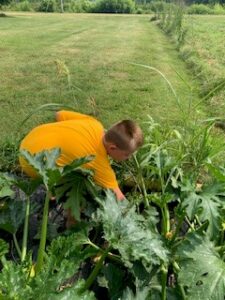
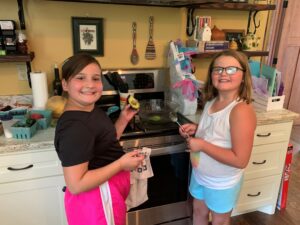
As part of our project, youth were engaged in implementing a farm to table project. As a result youth will continue to reflect and build on skills learned and apply this to designing their own garden beds for future seasons. The following lesson plan was utilized in guiding our farm to table project.
Project preparation
Set a date to have the planning meeting.
Assign roles and responsibilities for the project.
Order supplies for the raised bed gardens and greenhouse.
Build the greenhouse.
Deliver the items for the project.
Keep timelines for plants and necessary farming practices.
Set dates for field trips to farmer’s markets and farm tours.
Set a date and time for the nutritional lesson and make dinner.
Finish project with reflection and oral presentations.
Materials needed
- Raised beds
- Soil mixed with compost, seeds, plants, and garden tools
- Greenhouse kit
- Canning supplies for food preservation demonstration
Introduction/Motivation
Where does your food come from? How does it get in the grocery store? Would you like to learn how to grow some of your own food?
Performance objective:
At the end of the farming project, students will be able to explain where their food comes from, exploring how farming can be a viable business option, and harvest produce to make their own salsa.
Scope and Sequence
Students will meet in-person to plan the gardening project using raised beds.
A salsa garden theme was chosen to help students understand the correlation of the garden.
The farmer’s market field trip was planned to allow students to see products used to make money.
Build greenhouse and plant shared garden.
A farm tour allowed students to see where beef comes from and how steers are cared for on a farm.
A nutritional lesson, using the portion plate, helped to teach a balanced diet, serving sizes and food preservation.
Make a meal, using teamwork, with the items from the garden and the farmer's market.
Oral presentation on what each student learned from the project.
Reflection on the overall project and what could be done differently.
Application
The student will grow plants and seeds in a raised bed. The students will take a field trip and visit a produce farm and a beef farm. Youth will learn about the food pyramid and serving sizes. You will help plan and cook dinner using food from farms.
Evaluation
Formative evaluation consisted of an oral presentation wherein youth shared their favorite part of the project and what they learned from doing the project.
Conclusion of the project: This project had many layers to make it complete. The objective was to teach families to grow their own food during the summer season. Food prices are getting higher and harder to budget for, a project like this allows people to grow food in small spaces. This project was designed to be a family project and was successful in doing just that. We also introduced the families to Mckean's local farmer's market as well as a neighboring local beef farm. The kids were able to choose the food they wanted to prepare for dinner. They were excited to go to the TerraCotta house to prepare their meal together. I was impressed at how much they were able to do on their own, or with a little help. Gardening and cooking are sustainable skills for anyone to do with a little encouragement and support. The greenhouse will be used to grow plants to be planted in a community garden or given to local families to plant their own gardens each year.
